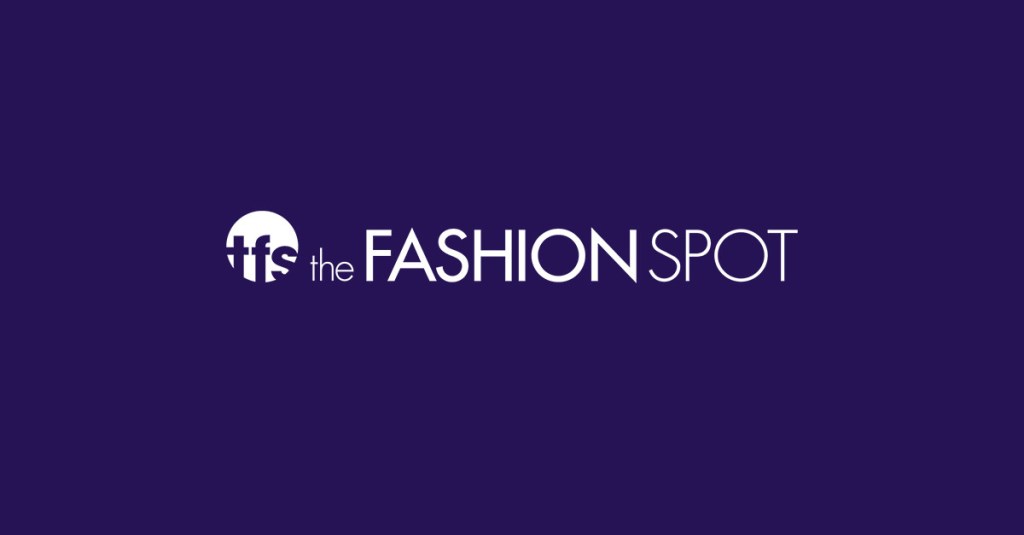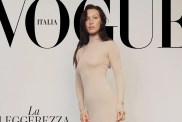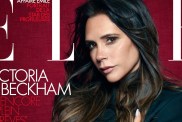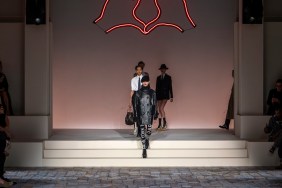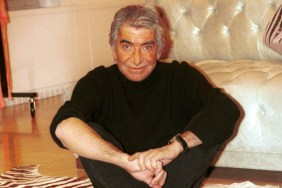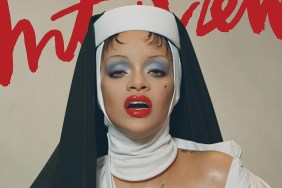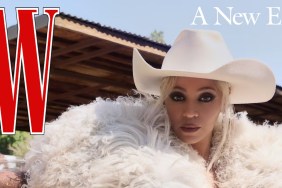TFS: You’re very popular on the Fashion Spot. We love your thread! You do some wonderful work and you’ve been doing this for soooo long.
EE: (laughs) For a long time!
TFS: You’ve had quite an amazing career.

EE: Thank you. I don’t know how, but somehow I managed it! (laughs)
TSF: And you started very young. That’s kind of remarkable. Do you think that could happen now?
EE: You know, I ask myself this question all the time… and I ask (other) people. I think that I started at a very different time. I think that when I started, fashion in England wasn’t as international as it is now. You know, we had two magazines that we worked for and I was sort of head of one. We had a thriving music industry where we made money- because we didn’t do advertising back then, we did pop stars/musicians. So we made money, and then that money was spent on your editorials. Things were kind of a little more innocent then. I think if I started now, to be fashion editor of a magazine at 17, it would probably be…

No…it would be very difficult. Things are a little more commercial and I think it’s a little more cut throat today. And Conde Nast is such a juggernaut now! Back then there were British Vogue and American Vogue and a few others. Now there’s every kind of Vogue, in every kind of country. So it was a very different time.

TFS: True, true. I was actually looking at some of your earlier work for I-D. I’m wondering what you think about your own work. Has it evolved? Has it changed as well, along with the market?
EE: Oh my god! I think more than anything that’s probably what’s kept me going. Because when I started off at I-D, things were very avant-garde, you know? Very based around second-hand clothes, and the markets, and not commercial. So, with the trajectory of my career, now I work at American Vogue. It’s almost like going from one extreme to another. And then there’s Italian Vogue. But I think somehow I’ve retained a personal kind of voice. You know, the woman that I always aspire to – it’s always a cool girl…from London…from Portobello! Somehow in my work, it’s always a girl like Kate Moss. Like, even when I’m styling it’s like…”Oh – how would that girl wear this or that…?”

TFS: Talk a little bit about that, about the process. How far in advance do you start preparing for a shoot, and how many looks do you pull for a story. I know with Italian Vogue it’s a tremendous amount of stuff…
EE: Yeah.
TFS: I know with some of the photographers they expect a certain amount of choices…
EE:Yes, it’s a LOT.

TFS: And do you know in advance what the looks are going to be, or do you do it on set?
EE: Of course, I work for three very different magazines. The process for each one is quite different, OK, so, I’ll run you through.
So, for I-D, it can start from a color somebody’s wearing…
it can start from something I see on the street…
it can start from an abstract idea …
and I’ll be like ’Oh god…that’s the idea!’…
Then, the character evolves. For me it’s always the person first, clothes second, location/whatever third. So I always start with some sort of a character. That works for all the magazines.
Like…
Who is this woman? Where is she in her life? So it’s almost like child’s play. So I start with a character, then once I’ve figure out who this character is, then the second part comes into play, which is- What does this character wear? I know a lot of stylists are lead by the collections, and say ‘I’m going to shoot this’. For me, it’s about the person first.
So once I’ve established that character, then I can be…
”Does she wear Galliano?…Does she wear Comme des Garcons?… Do we look at the shows?… Do we go to vintage? etc…”
So once that whole part is sorted, then… Where is she, this woman who dresses this way? Does she live in a house?… Does she live on the street?… Does she travel…?
So, for me it’s a three-step process. And somehow in all the magazines I work for, that’s the kind of process I apply. I never work the other way round saying, ‘This is on the runway, so this is the story.’ Because then you lose your character and the personality, if you know what I mean.

And the number of clothes really depends. When I work for I-D, I don’t have really any restrictions. So I tend to work with a lot of second-hand clothing, a lot of Japanese designers. I’ve always been obsessed with the Japanese, they’re incredible. That, for me, is the best part. So the character in I-D would probably be less restricted. On Italian Vogue, like you said, when you work with someone like Steven (Meisel), he is the ULTIMATE photographer, the ultimate teacher. I’ve learned so much from Steven. The stories are so complex and multi-faceted you have to really come with a LOT. Because the characters Steven and I create are so complex. As you can see, they are never black and white. The character could go from being an eccentric one minute to being the most angelic thing… in the same day even!

TFS: I guess you would say there are a lot of layers.
EE: YES, oh my god! A LOT of layers! And you probably end up pulling a lot more clothes.
And the process for American Vogue is, you start off and, you know, we work with Anna, Anna Wintour, who’s AMAZING! She has such a great foresight. So she helps you.

TFS: Do you do run-throughs with Anna?
EE: Yes, you have to do run-throughs, yes. You select the things you want to shoot. Again, you’ve worked on your idea, your woman. And then Anna and you will formulate where the clothes should go.
TFS: And how important is casting? Because your casting is very specific to you, I think.
EE: For me, it’s SO important… because I do like a certain kind of a girl. And the girl I like is not…it’s not the most commercial of girls. There’s always a certain beauty or inner beauty, but there’s always something a little off. I think growing up in London plays a very important part. I said this once in a stylist book – It’s like when you grow up as the son of immigrants, in England…when you go to school, you’re in one world and everything that’s beautiful is very different from when you’re at home, cause you’re in another world. It made me appreciate different kinds of beauty. So the girls I like are always a little off. Always cool, I’ll say. Oh…can we say a little twisted?! (laughs)

Do you know what I mean?
Look at a John Curran painting, Modigliani, those kinds of women. You can tell there’s so much going on under the surface, but they’re not your conventional idea of what beautiful is, you know?
And the girls that I use over and over again I guess you know….
Karen, Sacha, Kate

There was a time when Kate was left of center, you remember?!
When we started, Kate was like the weirdest looking thing!
TFS: Right! She was alien waif girl!
EE: And now she’s a renowned standard for beauty.
TFS: Exactly, so things have evolved in the industry. That’s what fashion is about, it’s about new…and changing…
EE: New and change…and being able to transcend that change and still retain who you are.

End of Part 1…Part 2 coming soon.
Images courtesy of the Fashion Spot forums.
